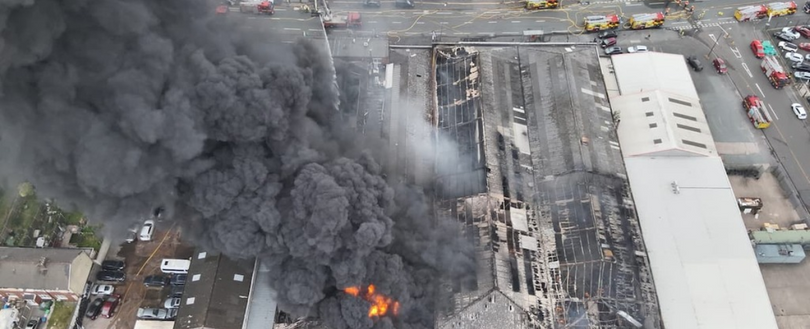
West Midlands Fire Devastates Factory Units, Raises Safety Concerns
Like it? Share it!
22 August 2025
The blaze, which is reported to have involved around 20 tonnes of tyres stored on-site, generated thick, toxic smoke and caused significant disruption across the local area.
With no sprinkler systems in place, the fire spread rapidly across approximately 4,400 m² of industrial space on Great Bridge Street. Seventeen fire engines and more than 100 firefighters from West Midlands and Staffordshire Fire and Rescue Services were deployed to tackle the flames, drawing water from a nearby canal to support operations.
Roads around the site were closed to provide access for Emergency Services vehicles, causing delays and congestion for local drivers and businesses. Several nearby homes were also evacuated as a precaution.
Business disruption and environmental impact
The affected buildings sit within a densely occupied industrial estate, home to a range of manufacturing and logistics companies. While no casualties were reported, the fire displaced tenants, interrupted operations and is expected to cause significant downtime for businesses. For some, this could mean lost revenue, missed deliveries and production delays.
The burning tyres raised further concerns, with acrid black smoke drifting across residential areas. Residents were advised to keep windows and doors shut while environmental authorities conducted air quality monitoring. The incident has intensified calls for a review of fire safety measures on sites storing high-risk materials.
Calls for change
“This is yet another example of how quickly a fire can escalate in the absence of automatic sprinkler systems and require a huge deployment of resources,” said Tom Roche, secretary of the Business Sprinkler Alliance. “Four businesses are now left counting the cost of a fire that could have been controlled in its early stages.”
The long-term consequences of the fire are expected to extend beyond immediate property damage, with costs linked to site clearance, environmental remediation and regeneration. Local authorities and business owners may face a lengthy and expensive recovery.
Sprinkler debate reignited
Once again, the absence of sprinkler protection has highlighted vulnerabilities in commercial buildings. Fires of this scale not only damage property but also put lives, livelihoods and Emergency Services personnel at risk.
“When sprinklers are installed, fires are typically contained or extinguished before they can cause major damage,” added Roche.
As investigations continue, questions remain over how many more incidents will be required before automatic fire suppression becomes a standard requirement rather than an optional feature.
The smoke has cleared from Great Bridge Street, but the message, campaigners argue, is clear: sprinklers save property, protect people and safeguard business continuity. Without them, industrial fires continue to consume far more than bricks and mortar.
